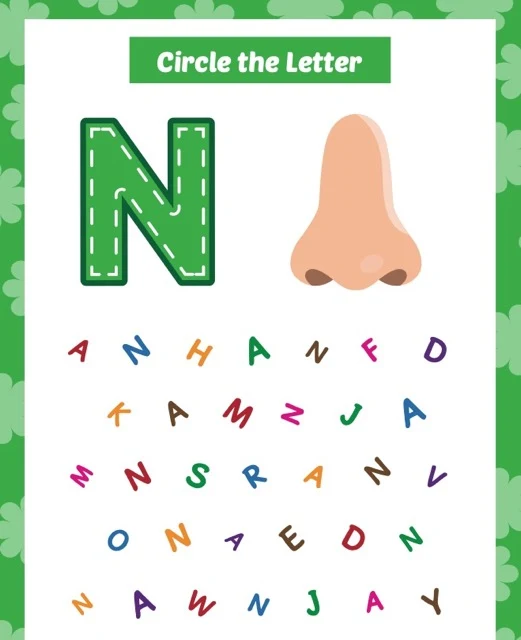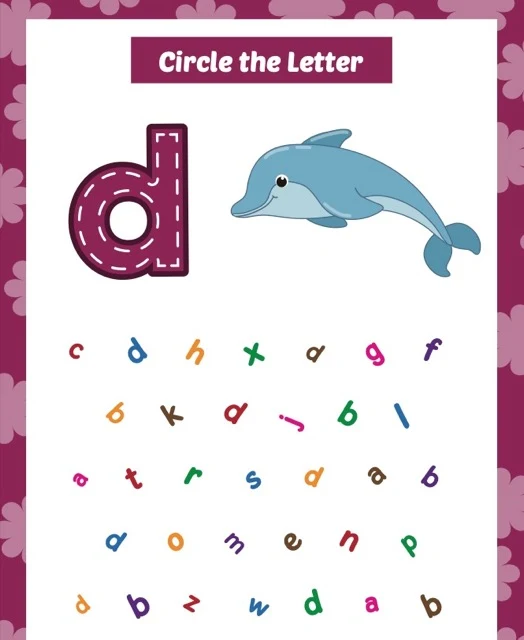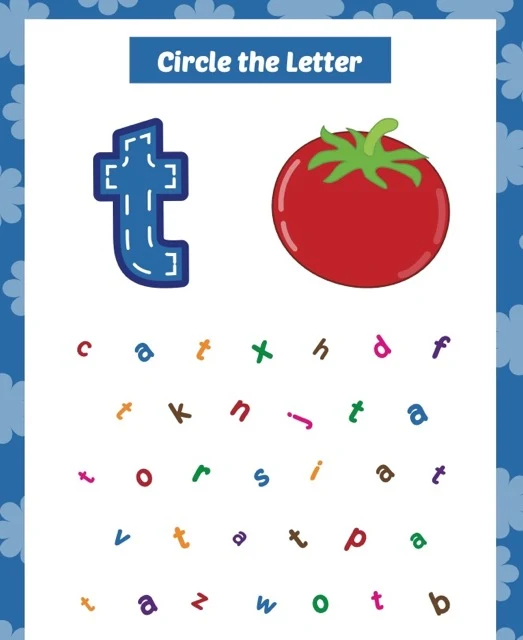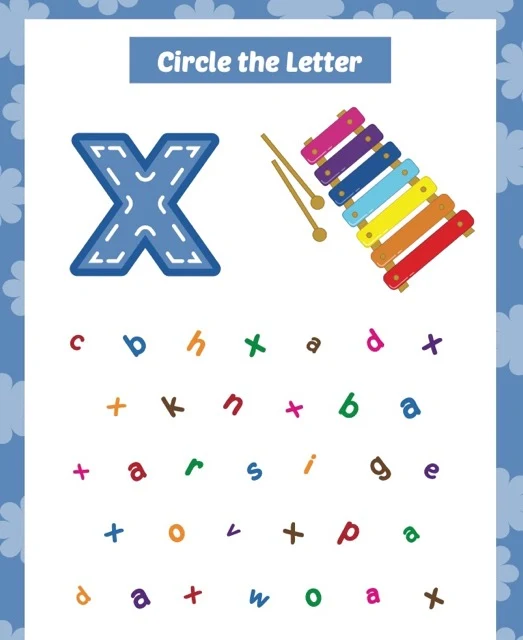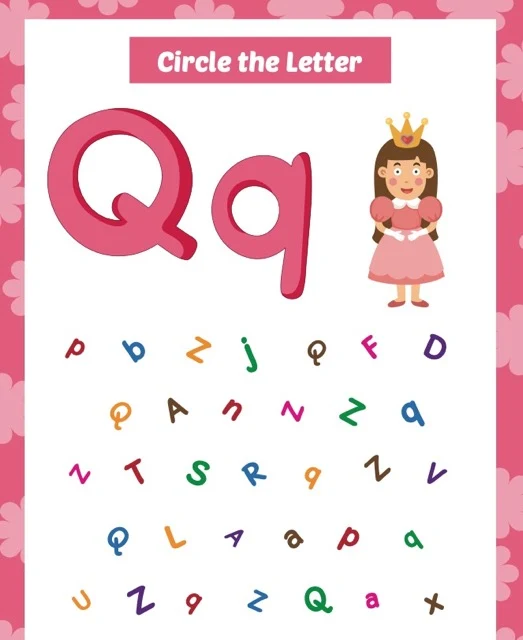Circle the Letters: A Literacy Activity
This briefing document examines the "Circle the Letters" activity, an educational tool designed to teach letter recognition to preschool and kindergarten children. Three sources analyze the activity's purpose, benefits (including improved fine motor skills and focus), design (featuring uppercase and lowercase letters with illustrations), and adaptability for different skill levels. The activity's multi-sensory approach is highlighted as key to its effectiveness in fostering literacy development. The study concludes that "Circle the Letters" is a versatile and effective tool for enhancing early literacy skills.
Circle the Letters Activity Guide
Briefing Document: "Circle the Letters" Activity Guide
Overview:
This briefing document analyzes the "Circle the Letters" activity, an educational tool designed to promote letter recognition in young learners. The analysis draws upon three sources:
1.
"Circle the Letters: An Alphabet Activity Guide": Provides a comprehensive overview of the activity, including its purpose, benefits, instructions, and potential variations.
2.
"Mastering Letter Recognition: A Study Guide": Offers a deeper analysis of the activity through quiz and essay questions, exploring its pedagogical value and connection to developmental milestones.
3.
"Testing Theme: Circle the Letters.pdf": Presents visual examples of the activity sheets, showcasing the layout, letter formats, and accompanying illustrations.
Main Themes and Key Findings:
●
Purpose and Target Audience: The primary objective of "Circle the Letters" is to enhance letter recognition skills in preschool and kindergarten students (ages 3-5). The activity guide states that it is "ideal for preschool and kindergarten students, or any child learning the alphabet and practicing letter recognition."
●
Educational Benefits:
○
Letter Recognition: The core benefit is the development of visual identification and discrimination of letters.
○
Fine Motor Skills: The act of circling refines hand-eye coordination and fine motor control.
○
Concentration and Focus: The search-and-find aspect cultivates attention to detail and sustained focus.
○
Alphabet Awareness: Repeated exposure fosters familiarity with the alphabetic sequence.
●
Activity Design and Structure:
○
Each page features a prominent uppercase letter along with a colorful illustration of an object or animal starting with that letter.
○
The accompanying grid contains a mix of uppercase and lowercase letters, prompting the child to identify and circle all instances of the target letter.
○
Progression involves introducing lowercase letters and variations in font styles, as highlighted in the study guide: "The progression of letter formats starts with uppercase letters and then moves to lowercase letters. Later in the activity, the focus shifts to recognizing the same letters in different fonts and styles."
●
Multi-Sensory Learning: "Circle the Letters" engages multiple senses: visual (seeing the letters and illustrations), kinesthetic (circling the letters), and auditory (verbalizing the letter names). The study guide emphasizes the importance of this approach: "Discuss the importance of multi-sensory learning in early childhood education. How does 'Circle the Letters' engage multiple senses to enhance learning?"
●
Adaptability and Differentiation: The activity can be adjusted for varying skill levels:
○
Beginners: Start with uppercase letters and provide highlighted examples.
○
Advanced Learners: Incorporate lowercase letters and more complex grids.
○
The activity guide also suggests thematic variations and the inclusion of numbers for further learning opportunities: "Theme-based grids, Color-coded letters, Number recognition."
Impact on Literacy Development:
Regular use of "Circle the Letters" has the potential to significantly contribute to a child's overall literacy development:
●
Foundation for Reading and Writing: Strong letter recognition is a fundamental prerequisite for decoding words and encoding sounds during reading and writing.
●
Vocabulary Expansion: Associating letters with pictures introduces new vocabulary and reinforces connections between words and their visual representations.
●
Motivation and Engagement: The colorful visuals and interactive nature of the activity can foster a positive attitude towards learning and encourage active participation.
Conclusion:
"Circle the Letters" is a versatile and effective educational tool that utilizes a multi-sensory approach to support early literacy development. Its adaptability makes it suitable for a range of learning styles and abilities, ensuring an engaging and rewarding learning experience for young children.
Circle the Letters: An Alphabet Activity Guide
Circle the Letters FAQ
What is "Circle the Letters"?
"Circle the Letters" is an educational activity designed for young learners. It involves identifying a specific letter of the alphabet and circling all instances of that letter within a grid. Each page focuses on a single letter and features a colorful illustration of an object or animal that begins with that letter.
What age group is "Circle the Letters" appropriate for?
This activity is ideal for preschool and kindergarten students, or any child learning the alphabet and practicing letter recognition.
What are the benefits of using "Circle the Letters"?
This activity offers several educational benefits:
●
Letter Recognition: Children learn to visually identify and distinguish different letters.
●
Fine Motor Skills: Circling the letters helps develop hand-eye coordination and fine motor control.
●
Concentration and Focus: The search-and-find aspect encourages attention to detail and sustained focus.
●
Alphabet Awareness: Children become familiar with the order and sequence of letters in the alphabet.
How do I use "Circle the Letters"?
1.
Present one page at a time: Focus on one letter per session.
2.
Identify the target letter: Point to the large letter at the top and name it aloud.
3.
Search and circle: Guide the child to search for all the matching letters in the grid and circle them.
4.
Use a variety of tools: Encourage using crayons, markers, or pencils for circling.
5.
Make it fun: Use positive reinforcement and praise to motivate the child.
Can I adapt "Circle the Letters" for different skill levels?
Yes! You can differentiate the activity based on the child's abilities:
●
Beginners: Start with uppercase letters and use a highlighter to pre-circle a few examples.
●
Advanced learners: Introduce lowercase letters or challenge them to find and circle both uppercase and lowercase letters.
Are there variations of "Circle the Letters"?
Absolutely! You can create your own variations:
●
Theme-based grids: Create grids with letters hidden among pictures related to a specific theme (animals, food, colors, etc.).
●
Color-coded letters: Use different colored letters within the grid and ask children to circle a specific color.
●
Number recognition: Replace letters with numbers and have children circle specific numbers.
Can I use "Circle the Letters" in a classroom setting?
Yes, this activity works well for:
●
Individual practice: Provide each child with a worksheet for independent work.
●
Small groups: Divide students into groups and have them work collaboratively.
●
Whole class activity: Project a page on a screen and have students circle letters together.
Where can I find more resources like "Circle the Letters"?
There are numerous websites and educational publishers that offer similar letter recognition activities and worksheets. You can also find inspiration for creating your own variations. Search for "letter recognition activities for preschool" or "alphabet worksheets for kindergarten."
Mastering Letter Recognition: A Study Guide
Mastering Letter Recognition: A Study Guide
Quiz
1.
What is the primary objective of the "Circle the Letters" activity?
2.
How do the visuals on each page contribute to the learning process?
3.
What age group do you think this activity is most appropriate for? Why?
4.
Beyond letter recognition, what other skills could this activity help develop?
5.
How might a caregiver or educator modify this activity for a child with learning differences?
6.
Describe the progression of letter formats used throughout the pages.
7.
What is the benefit of including images alongside each letter?
8.
How could this activity be incorporated into a lesson about different animals or objects?
9.
What role does repetition play in the effectiveness of this learning tool?
10.
Suggest one additional activity that could complement and reinforce the skills learned from "Circle the Letters".
Quiz Answer Key
1.
The primary objective of the "Circle the Letters" activity is to help children practice and strengthen their letter recognition skills.
2.
The visuals on each page provide a visual representation of the letter being focused on and also offer an engaging element that keeps children interested. They help connect the abstract concept of letters with familiar objects or animals.
3.
This activity is likely most appropriate for preschool or kindergarten children (ages 3-5). This is the age when children are typically beginning to learn the alphabet and developing their fine motor skills for circling.
4.
Beyond letter recognition, this activity can help develop fine motor skills (circling), color recognition, visual discrimination, and vocabulary related to the images presented.
5.
For children with learning differences, the activity could be modified by using larger letters, reducing the number of distractor letters on each page, or allowing the child to use different colored markers for each target letter.
6.
The progression of letter formats starts with uppercase letters and then moves to lowercase letters. Later in the activity, the focus shifts to recognizing the same letters in different fonts and styles, further reinforcing letter recognition skills.
7.
Including images alongside each letter helps children make connections between the letter and a real-world object or animal. This visual association aids in memory and recall of the letter.
8.
This activity could be incorporated into a lesson by having children identify and circle letters that correspond to the names of the animals or objects being discussed. This reinforces both letter recognition and vocabulary.
9.
Repetition is crucial for young learners as it reinforces letter shapes and sounds. Repeated exposure to the letters in various formats aids memorization and mastery of letter recognition.
10.
A complementary activity could be a letter matching game, where children match uppercase and lowercase letters or match letters to corresponding picture cards.
Essay Questions
1.
Analyze the design choices in "Circle the Letters" and discuss their effectiveness in achieving the learning objectives.
2.
Discuss the importance of multi-sensory learning in early childhood education. How does "Circle the Letters" engage multiple senses to enhance learning?
3.
Explain how the "Circle the Letters" activity aligns with key developmental milestones in early literacy.
4.
Evaluate the potential impact of regular use of the "Circle the Letters" activity on a child's overall literacy development.
5.
Compare and contrast the benefits of using traditional paper-based activities like "Circle the Letters" versus digital apps for learning letter recognition.
Glossary of Key Terms
●
Letter Recognition: The ability to identify and name letters of the alphabet.
●
Fine Motor Skills: The coordination of small muscles, such as those used in writing, drawing, and manipulating objects.
●
Visual Discrimination: The ability to perceive differences between objects or symbols, such as distinguishing between different letters.
●
Vocabulary: The set of words that a person knows and understands.
●
Multi-Sensory Learning: A teaching approach that engages multiple senses (sight, hearing, touch, smell, taste) to enhance learning and memory.
●
Early Literacy: The skills and knowledge that children develop before they can read and write conventionally. These skills include phonological awareness, print awareness, and oral language development.
●
Developmental Milestones: A set of functional skills or abilities that most children can do at a certain age range.













